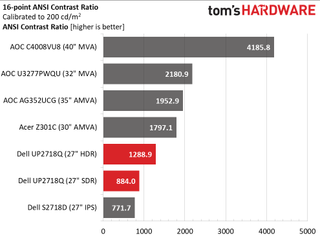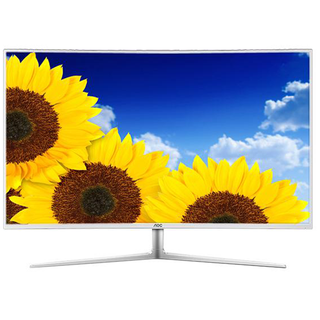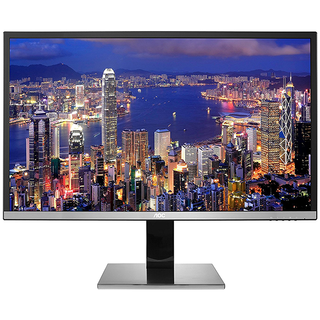Dell UP2718Q Ultra HD HDR Professional Monitor Review
Why you can trust Tom's Hardware
Brightness & Contrast
To read about our monitor tests in depth, please check out Display Testing Explained: How We Test Monitors and TVs. Brightness and Contrast testing are covered on page two.
Uncalibrated – Maximum Backlight Level
At this writing, the UP2718Q is a unique display and we have nothing like it in our review database. The closest comparison we can make is to VA-based panels, which offer much higher native contrast than IPS or TN. Today’s group includes AOC’s AG352UCG, U3277PWQU, and C4008VU8, along with Acer’s Z301C, and Dell’s S2718D, which also supports HDR10.



When processing HDR signals, the UP2718Q’s backlight is in full zone-dimming mode, which means the 384 individual LEDs can be made darker or brighter according to content. When measuring a full-field pattern in SDR mode, we saw a peak output of 360.2752cd/m2, which is typical for an IPS panel. In HDR mode, we used a 10% window pattern and recorded over 1100cd/m2.
This superior performance extends to black levels that are VA-like in HDR mode. The UP2718Q is blacker than all the VA screens here except the C4008VU8, which has a dimmer backlight. That makes for an amazing sequential contrast result of more than 17,000:1. SDR contrast is a decent 1016.9:1, putting it near the top of the IPS heap.
It should be noted that the best plasma displays, before their unfortunate disappearance from the marketplace, were capable of contrast ratios exceeding 50,000:1. We still have a Pioneer PRO-111FD panel from 2009 that can achieve this in our lab. And LG OLED televisions have an even broader dynamic range with unmeasurable black levels. While zone-dimming is a major enhancement to LCD technology, it still comes up short of OLED and plasma in the native contrast department.
Uncalibrated – Minimum Backlight Level



The backlight goes to a low level with a 31.0169cd/m2 minimum and 960:1 contrast. This is reasonably consistent but not quite as much as many other panels we’ve reviewed. We also noticed the backlight doesn’t modulate evenly. Some clicks of the slider produce changes of more than 10cd/m2 while others register no change. Setting a precise level is difficult, but we were able to hit 200nits for our calibrated tests.
After Calibration to 200cd/m2


Since we didn’t perform a full calibration, the above charts represent the sRGB preset with brightness set to 56%. Black level and contrast performance is consistent with the premium IPS panels found in professional monitors. In SDR mode, the UP2718Q is a capable display with good contrast and excellent picture quality, mainly thanks to its high pixel density.
ANSI Contrast Ratio

We performed the ANSI test in both SDR and HDR modes, using a checkerboard pattern that represents an average picture level (APL) of 50%. As you can see, the UP2718Q can’t quite hit 1000nits in this case. Peak readings ranged from 420 to 460cd/m2 while black levels were around .34cd/m2. This provides a bump in intra-image contrast but not a significant one. This shows how the zone-dimming system works in concert with the content’s APL. As the percentage rises, dynamic range shrinks. When we measured just a 10% white window, we got the full 1100nits output.
In SDR mode, performance is again like other premium IPS monitors but well below the VA panels in the group. For native contrast, VA is still king, but without a zone-array backlight, it lacks the ability to match the high specific output levels of the UP2718Q. When those two technologies come together in a single desktop display, that will be a glorious day.
MORE: Best Gaming Monitors
MORE: Best Professional Monitors
MORE: How We Test Monitors
MORE: How To Choose A Monitor
MORE: All Monitor Content
Current page: Brightness & Contrast
Prev Page OSD Setup & Calibration Next Page Grayscale, Gamma & ColorStay On the Cutting Edge: Get the Tom's Hardware Newsletter
Get Tom's Hardware's best news and in-depth reviews, straight to your inbox.

Christian Eberle is a Contributing Editor for Tom's Hardware US. He's a veteran reviewer of A/V equipment, specializing in monitors. Christian began his obsession with tech when he built his first PC in 1991, a 286 running DOS 3.0 at a blazing 12MHz. In 2006, he undertook training from the Imaging Science Foundation in video calibration and testing and thus started a passion for precise imaging that persists to this day. He is also a professional musician with a degree from the New England Conservatory as a classical bassoonist which he used to good effect as a performer with the West Point Army Band from 1987 to 2013. He enjoys watching movies and listening to high-end audio in his custom-built home theater and can be seen riding trails near his home on a race-ready ICE VTX recumbent trike. Christian enjoys the endless summer in Florida where he lives with his wife and Chihuahua and plays with orchestras around the state.
-
idontrememberit About the anti-glare, can you confirm if the graininess is visible on black text with white background?Reply -
gmayol Do you think this features imply the same increment in the total bill of materials than in price or engineering expenses ? should we see this technology on cheaper models ?Reply -
samer.forums $1500 is too much for this. its 27 inch only .. there are 43-55 inch TVs at the same price with the same specs , 10bit , HDR10 and wide color gamut.Reply -
hannibal The point is They have not the same nits as this device!Reply
If you read there Are Many monitors that claim hdr but can not actually show it. Same with cheap tv sets. -
samer.forums Reply20321789 said:The point is They have not the same nits as this device!
If you read there Are Many monitors that claim hdr but can not actually show it. Same with cheap tv sets.
Latest Sony TVs are VERY BRIGHT .. check them out the 2017 models. -
TheDane HDR is not about nits only. OLED TVs are superior to even the best LCD HDR TVs even though they currently max out at aroung 700 nits. I'd rather have a 500 nits "only" OLED TV than a 500 zone +1000 nits LCD TV. The per-pixel black level are important for maximum detail.Reply -
trevor_dennis Nice, but I'll never trust a Dell monitor again. My admittedly aging 2709W has had the very common vertical line issue for a few years now, and Google tells me I am far from alone. Checking the user reviews on Amazon shows an appallingly low satisfaction with new Dell screens indicating a roughly one in five chance of getting a lemon, and huge problems getting it fixed if you do. You end up with a refurbished screen (second hand) which may or may not develop the same issue. If you get a good one, they are great value, but I am just not prepared to risk it.Reply -
jn77 I have 3 Dell UltraSharp 2408WFP's and they were premium monitors at the time and 1 month after the warranty expired I got the vertical line issue on all of them. I am also done with Dell Monitor's also.Reply -
samer.forums Reply20323968 said:You lost me at 16:9 :(
True .. 16:10 is better for professional work


